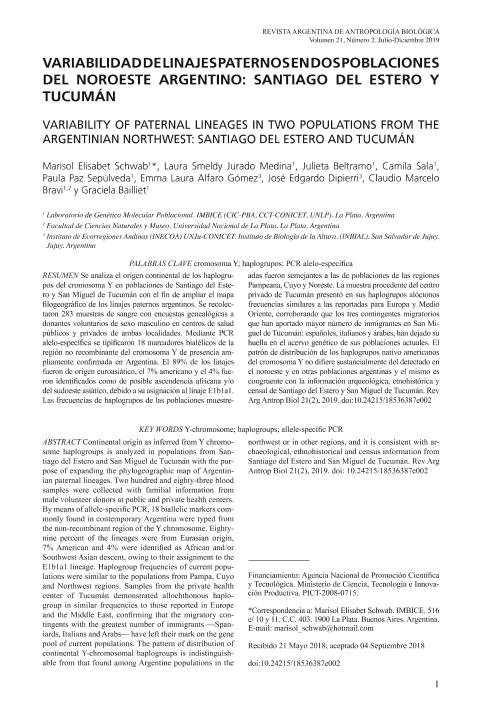Artículo
Se analiza el origen continental de los haplogrupos del cromosoma Y en poblaciones de Santiago del Estero y San Miguel de Tucumán con el fin de ampliar el mapa filogeográfico de los linajes paternos argentinos. Se recolectaron 283 muestras de sangre con encuestas genealógicas a donantes voluntarios de sexo masculino en centros de salud públicos y privados de ambas localidades. Mediante PCR alelo-específica se tipificaron 18 marcadores bialélicos de la región no recombinante del cromosoma Y de presencia ampliamente confirmada en Argentina. El 89% de los linajes fueron de origen euroasiático, el 7% americano y el 4% fueron dentificados como de posible ascendencia africana y/o del sudoeste asiático, debido a su asignación al linaje E1b1a1. Las frecuencias de haplogrupos de las poblaciones muestreadas fueron semejantes a las de poblaciones de las regiones Pampeana, Cuyo y Noreste. La muestra procedente del centro privado de Tucumán presentó en sus haplogrupos alóctonos frecuencias similares a las reportadas para Europa y Medio Oriente, corroborando que los tres contingentes migratorios que han aportado mayor número de inmigrantes en San Miguel de Tucumán: españoles, italianos y árabes, han dejado su huella en el acervo genético de sus poblaciones actuales. El patrón de distribución de los haplogrupos nativo americanos del cromosoma Y no difiere sustancialmente del detectado en el noroeste y en otras poblaciones argentinas y el mismo es congruente con la información arqueológica, etnohistórica y censal de Santiago del Estero y San Miguel de Tucumán Continental origin as inferred from Y chromosome haplogroups is analyzed in populations from Santiago del Estero and San Miguel de Tucumán with the purpose of expanding the phylogeographic map of Argentinian paternal lineages. Two hundred and eighty-three blood samples were collected with familial information from male volunteer donors at public and private health centers. By means of allele-specific PCR, 18 biallelic markers commonly found in contemporary Argentina were typed from the non-recombinant region of the Y chromosome. Eightynine percent of the lineages were from Eurasian origin, 7% American and 4% were identified as African and/or Southwest Asian descent, owing to their assignment to the E1b1a1 lineage. Haplogroup frequencies of current populations were similar to the populations from Pampa, Cuyo and Northwest regions. Samples from the private health center of Tucumán demonstrated allochthonous haplogroup in similar frequencies to those reported in Europe and the Middle East, confirming that the migratory contingents with the greatest number of immigrants —Spaniards, Italians and Arabs— have left their mark on the gene pool of current populations. The pattern of distribution of continental Y-chromosomal haplogroups is indistinguishable from that found among Argentine populations in the northwest or in other regions, and it is consistent with archaeological, ethnohistorical and census information from Santiago del Estero and San Miguel de Tucumán
Variabilidad de linajes paternos en dos poblaciones del Noroeste Argentino: Santiago del Estero y Tucumán
Título:
Variability of paternal lineages in two populations from the Argentinian Northwest: Santiago del Estero and Tucumán
Schwab, Marisol Elisabet ; Jurado Medina, Laura Smeldy
; Jurado Medina, Laura Smeldy ; Beltramo, Julieta; Sala, Camila; Paz Sepúlveda, Paula Beatriz
; Beltramo, Julieta; Sala, Camila; Paz Sepúlveda, Paula Beatriz ; Alfaro Gómez, Emma Laura
; Alfaro Gómez, Emma Laura ; Dipierri, Jose Edgardo; Bravi, Claudio Marcelo
; Dipierri, Jose Edgardo; Bravi, Claudio Marcelo ; Bailliet, Graciela
; Bailliet, Graciela
 ; Jurado Medina, Laura Smeldy
; Jurado Medina, Laura Smeldy ; Beltramo, Julieta; Sala, Camila; Paz Sepúlveda, Paula Beatriz
; Beltramo, Julieta; Sala, Camila; Paz Sepúlveda, Paula Beatriz ; Alfaro Gómez, Emma Laura
; Alfaro Gómez, Emma Laura ; Dipierri, Jose Edgardo; Bravi, Claudio Marcelo
; Dipierri, Jose Edgardo; Bravi, Claudio Marcelo ; Bailliet, Graciela
; Bailliet, Graciela
Fecha de publicación:
18/06/2019
Editorial:
Asociación Antropología Biológica Argentina
Revista:
Revista Argentina Antropología Biológica
ISSN:
1514-7991
Idioma:
Español
Tipo de recurso:
Artículo publicado
Clasificación temática:
Resumen
Palabras clave:
CROMOSOMA Y
,
HAPLOGRUPOS
,
PCR ALELO ESPECIFICA
,
NOA
Archivos asociados
Licencia
Identificadores
Colecciones
Articulos(IMBICE)
Articulos de INST.MULTIDISCIPL.DE BIOLOGIA CELULAR (I)
Articulos de INST.MULTIDISCIPL.DE BIOLOGIA CELULAR (I)
Citación
Schwab, Marisol Elisabet; Jurado Medina, Laura Smeldy; Beltramo, Julieta; Sala, Camila; Paz Sepúlveda, Paula Beatriz; et al.; Variabilidad de linajes paternos en dos poblaciones del Noroeste Argentino: Santiago del Estero y Tucumán; Asociación Antropología Biológica Argentina; Revista Argentina Antropología Biológica; 21; 2; 18-6-2019; 1-13
Compartir
Altmétricas



